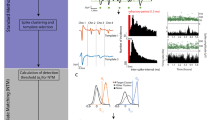Abstract
A hardware-based discriminator for multiunit signals is presented. In this system, the peak amplitude of a spike is adopted as the feature measure for spike classification. Adaptive discrimination is realised according to an original idea that clusters, on which the classification is performed, are updated in a space of feature measures as the peak amplitudes of the spikes change. This system works in a fully automatic way. It recognises the number of neuron units contained in a multiunit signal and then assigns an output channel to each unit in descending order of spike amplitude. Because of these characteristics, this system can work effectively even in common situations which laborious experimental procedures demand and stable discrimination should continue during a long session of recording for the time-dependency of feature measures of spike waveform. The effectiveness and superior performance of this instrument are evident from the practical results obtained in the application of the system to simulated and neuronal multiunit signals.
Similar content being viewed by others
References
D'Hollander, E. H. andOrban, G. A. (1979) Spike recognition and online classification by unsupervised learning system.IEEE Trans.,BME-26, 279–284.
Fukishima, Y., Nakao, M., Munemori, J., Hara, K.-I., Kimura, M. andSato, R. (1982) Spatio-temporal organization of the cat retinal ganglion cells. Papers of Tech. Group on Med. Electron. and Bion., IECE Japan, MBE 82-34.
Kojima, G. K. andBracchi, F. (1980) A microprocessor-based instrument for neural pulse wave analysis.IEEE Trans.,BME-27, 515–519.
Mastronarde, D. N. (1983) Interaction between ganglion cells in cat retinal.J. Neurophysiol.,49, 350–365.
McCann, G. D. (1973) Interactive computer strategies for living nervous system research.IEEE Trans.,BME-20, 1–11.
Mishelevich, D. J. (1970) On-line real-time digital computer separation of extracellular neuroelectric signals.Ibid. IEEE Trans.,BME-17, 147–150.
Ohmura, K., Nakao, M. andSato, R. (1983a) An analysis by the multiunit nerve spikes in the visual system. Papers of Tech. Group on Med. Electron. & Bion., IECE Japan, MBE82-121.
Ohmura, K., Nakao, M., Hara, K.-I., Kimura, M. andSato, R. (1983b) Statistical analysis of multiunit neuronal spikes in the visual system. Papers of Tech. Group on Med. Electron. & Bion., IECE Japan, MBE83-45.
Schiller, P. H. andMalpeli, J. C. (1978) Functional specificity of lateral geniculate nucleus laminae of the rhesus monkey.J. Neurophysiol.,41, 788–797.
Shimada, Y., Hoshimiya, N. andMatsuo, M. (1979) Analysis of multi-channel data in the peripheral nervous system—multichannel transducer characteristics of mechanoreceptors in the frog's sartorius muscle.Jpn. J. Med. & Biol. Eng.,17, 45–52.
Strong, D., Tatton, W. andCrapper, D. (1971) Solid-state amplitude discriminator for neural units.IEEE Trans.,BME-18, 237–240.
van der Molen, J. N., de Kramer, J. J. andPasveer, F. J. (1978) Peak-discriminator-controlled sampling of multi-unit spike trains, reducing storage requirements.Med. & Biol. Eng. & Comput.,16, 564–568.
Author information
Authors and Affiliations
Rights and permissions
About this article
Cite this article
Nakao, M., Ohmura, K. & Sato, R. Hardware-based adaptive system for discrimination of neuronal spikes. Med. Biol. Eng. Comput. 26, 360–366 (1988). https://doi.org/10.1007/BF02442292
Received:
Issue Date:
DOI: https://doi.org/10.1007/BF02442292




